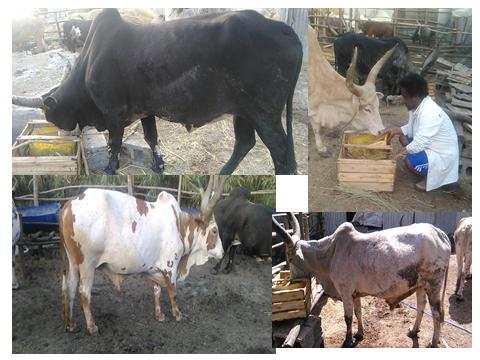Previous issue | Next issue | Archive
Volume 7 (2); March 25, 2017 [Booklet]
Research Paper
Influence of different feed forms and particle size on efficiency of broiler production.
Nabi F, Ismail Rind M, Li J, Zulqarnain M, Shahzad M, Ahmed N, Kashif Iqbal M and Rehman MU.
Online J. Anim. Feed Res., 7(2): 24-28, 2017; pii: S222877011700005-7
Abstract
The influence of different feed forms and particle size on feed and water intake, live body, carcass weight, internal organs weight and the performance in broiler chicks was examined. A total one hundred and fifty chicks were distributed into groups A, B and C. Group A was served with mash feed, and group B and C were fed with crumble feed of 1, 2 and 3 mm and 1.5, 2.5 and 3.5 mm particle size each at a pre-starter, starter and finisher phases, respectively. Result show that feed forms had significant influence on the growth of broilers. Feed and water intake also live body weight in crumble fed group C were higher (P < 0.05) than group B and A. Alongside carcass weight in group C was also higher than group B and A. The broiler liver, heart, gizzard and intestine weight found higher in group C than group B and A significantly (P < 0.01). In conclusion, the crumble feed form showed improvement of growth in broiler chicken. The crumble feed form of 1.5, 2.5 and 3.5 mm particle size at pre-starter, starter and finisher ration may be preferred for higher production and feed conversion ratio in broiler chicken.
Keywords: Broiler, Crumble, Feed form, Mash, Pellet, Production
Cattle selection criteria and fattening practices in urban and peri-urban Kebeles of Dessie and Kombolcha Towns, Ethiopia.
Ahmed K, Tamir B, Mengistu A.
Online J. Anim. Feed Res., 7(2): 29-37, 2017; pii: S222877011700006-7
Abstract
The aim of this research was to investigate cattle selection criteria and fattening practices in urban and peri-urban kebeles of Dessie and Kombolcha towns, Ethiopia. In this study, structured questionnaire was administered to a total of 337 cattle fattener households. Complete enumeration techniques were applied to select urban and peri-urban kebeles. The results indicated culturally cattle fattening management activities were left to males and age, castration condition, sex, breed/type, farming condition and growth stage were the identified cattle selection criteria for fattening in both towns. As per group discussion, in both study towns peri-urban cattle fatteners were practiced cattle fattening in dry and wet season whereas urban cattle fatteners only practiced in dry season. In both study towns peri-urban cattle fatteners (100%) were dominantly fatten cattle once per year and on average one fattening duration take three, four and five months based on 24.8%, 52.3%, 22.8% and 33.3%, 28.4%, 38.3% households response, respectively. 100% of urban cattle fatteners were dominantly fattened cattle twice per year and on average one fattening duration has taken two months, and two and half months based on 75.6% and 24.4% of urban fatteners response in Dessie town, respectively; whereas, 62.1% and 37.9% of urban fatteners in Kombolcha town reported two, two and half and three months of duration, respectively. Therefore, to boost up the newly emerging urban as well as peri-urban cattle fattening sector scientific intervention should be initiated for further improvement in fattening practices based on the generated information.
Keywords: Cattle, Fattening system, Peri-urban, Urban
Effect of graded levels of browse forage (Balanites aegyptiaca) leaves inclusion in the diets of growing rabbits.
Andrew John A, Nasiru A, Dauda A and Yakubu Nenrotmwa R.
Online J. Anim. Feed Res., 7(2): 38-42, 2017; pii: S222877011700007-7
Abstract
Thirty mixed sex cross breeds (chinchilla x California x New Zealand) weaner rabbits aged 4 weeks old were used to evaluate the effect of graded levels of browse forage (Balanites aegyptiaca) leaves inclusion in the diets of growing rabbits on growth performance and nutrient digestibility of weaner rabbits. Five diets were formulated, treatment 1(control), 2 3 4 and 5 in which Groundnut haulm was replaced with Balanites aegyptiaca at 0%, 5%, 10%, 15%, and 20% respectively. The rabbits were allotted to the five treatments (T1, T2, T3, T4, and T5) with two rabbits per replicate and six rabbits per treatment in a randomized complete block design. The rabbits were fed with the experimental diets and clean drinking water ad libitum for experimental period of eight weeks (56 days). All the parameters under observation showed significant (P < 0.05) difference among the treatment groups. In conclusion Balanites aegyptiaca leave meal can replace groundnut haulm without adverse effect on the rabbits.
Keywords: Rabbit, Balanite aegyptiaca and Groundnut Haulm
Previous issue | Next issue | Archive
This work is licensed under a Creative Commons Attribution-NonCommercial 4.0 International License.
| < Prev | Next > |
|---|






